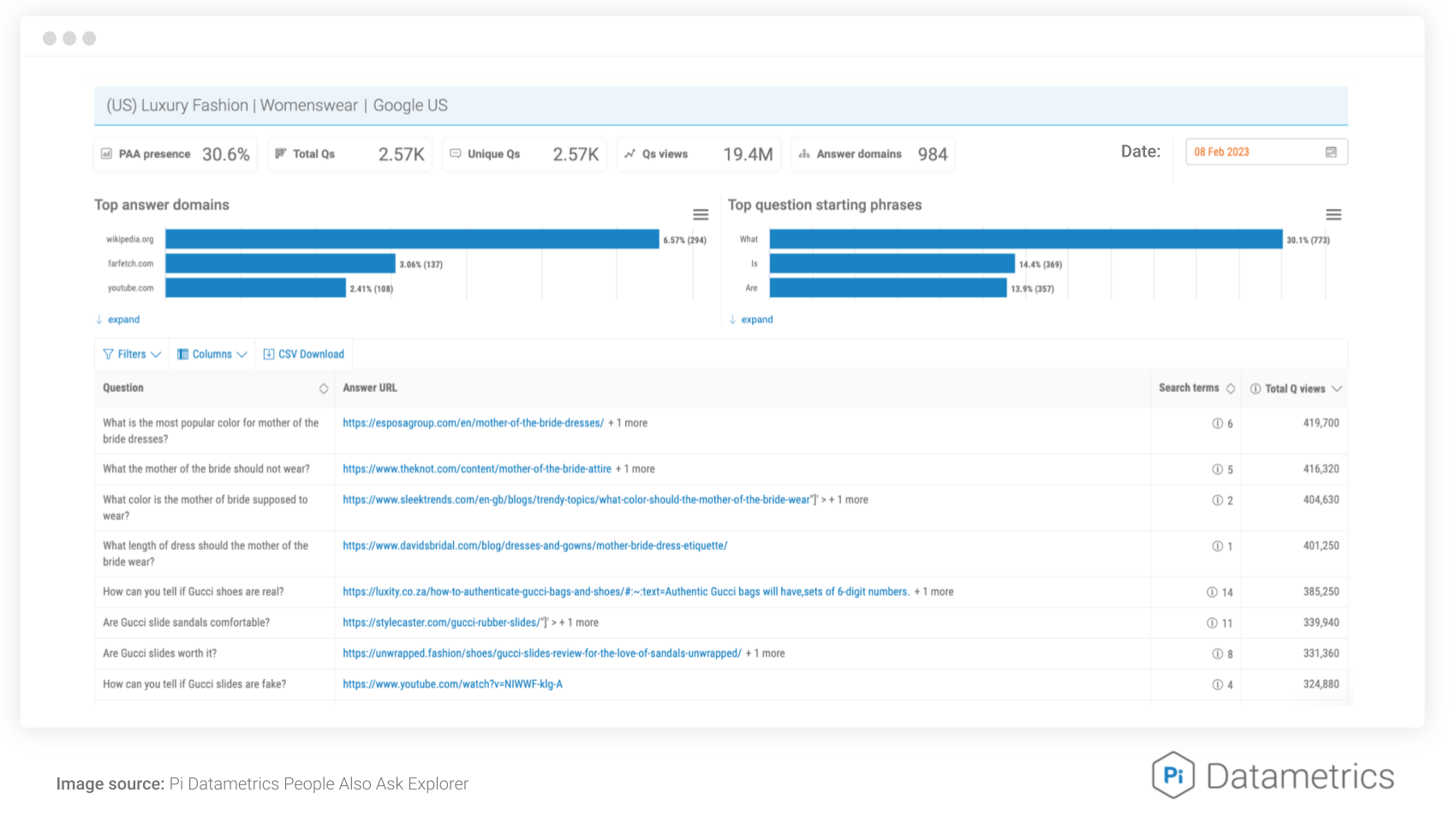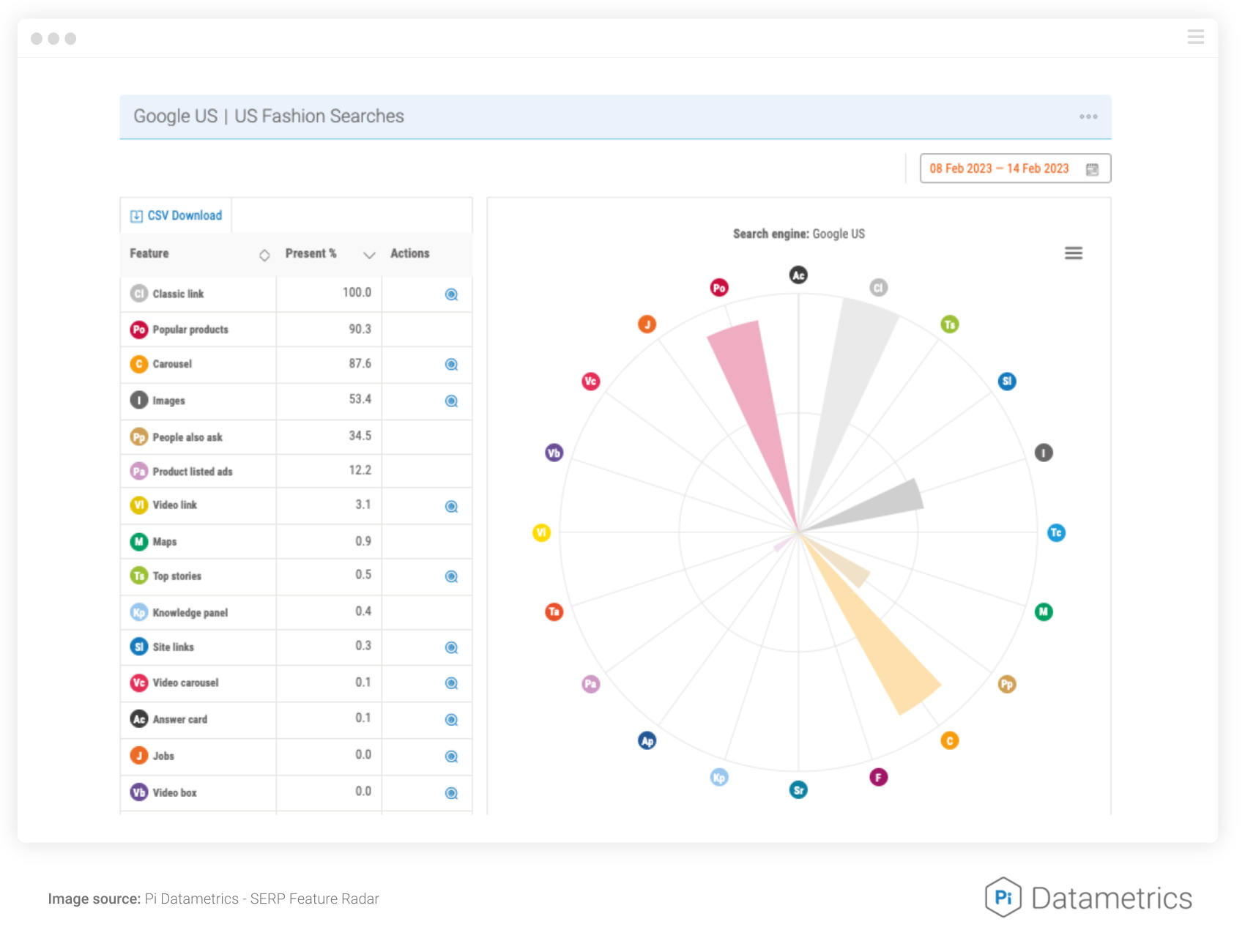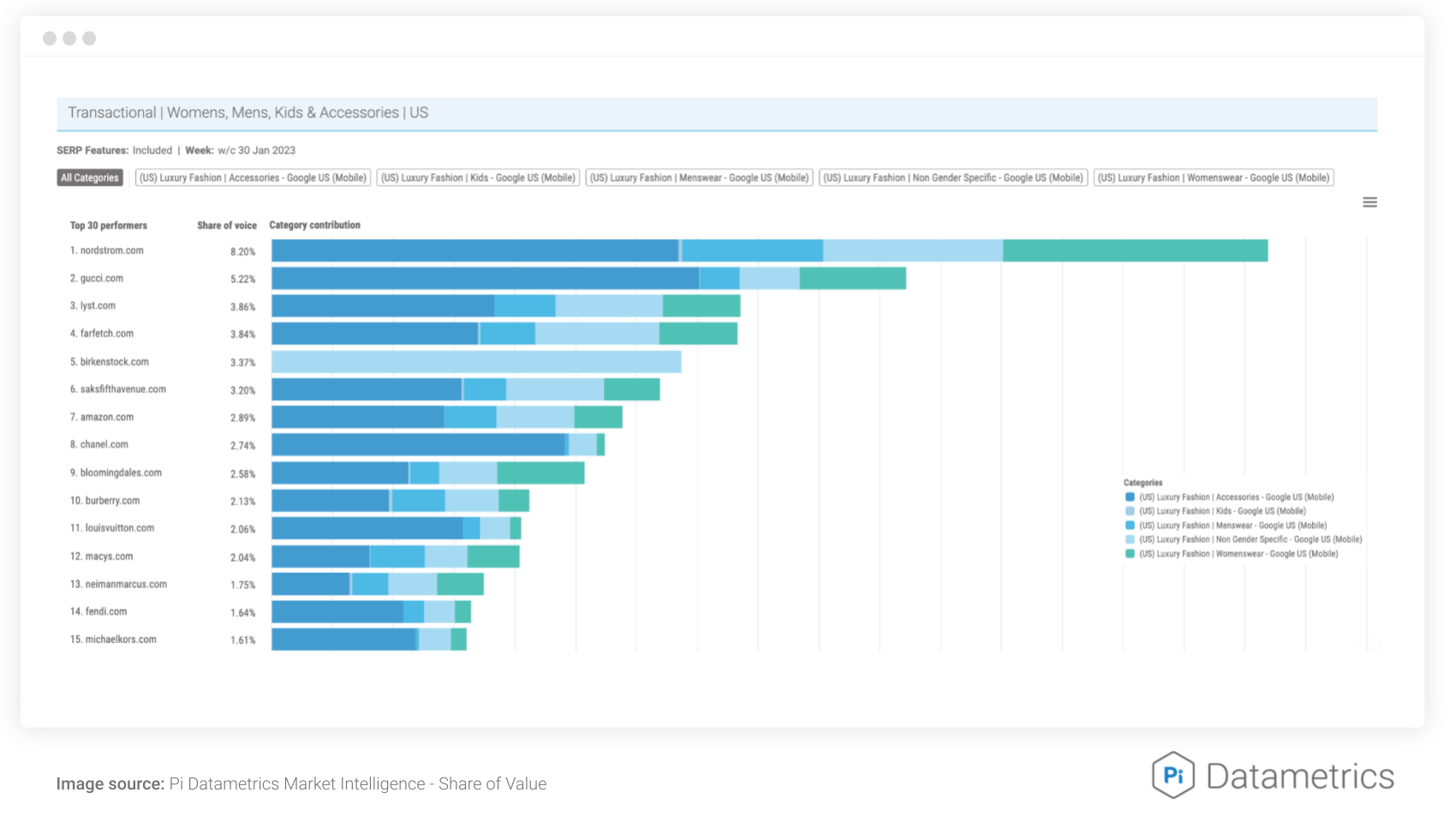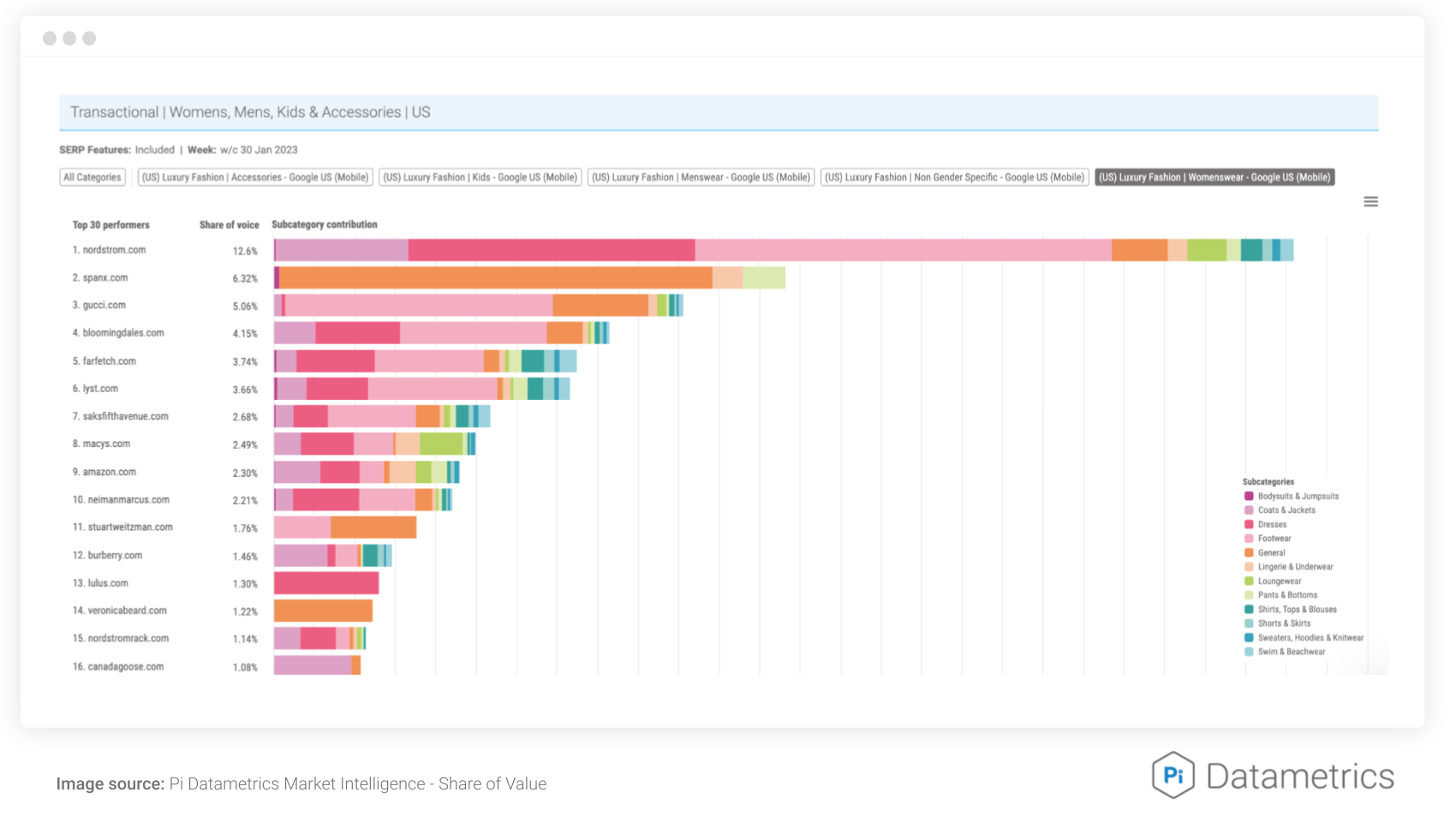SEO
5 Ways To Drastically Improve The ROI Of Your SEO Strategy

In the chart above, you can see that a “target” zone has been identified within Pi Datametrics Market Intelligence‘s Estimated Revenue Opportunity.
Content for these key terms is ranking well enough, but it’s currently sitting outside the positions that get the highest number of clicks (and ultimately, revenue).
Once you have identified this low-hanging fruit, it’s a great place to focus your efforts and optimize accordingly.
There are often easy fixes within this target area, for example, sorting out internal linking causing content cannibalization.
If you can also identify how much additional revenue you would gain from improving this target content; this will help you build internal business cases for getting technical website fixes into release cycles.
How To Capitalize On Medium-Volume Keywords
- Identify: Find and identify content where the opportunity has already been established and you have content that already exists. Look at the content you have sitting on pages 2 and 3 of Google.
- Prioritize: Focus on the terms with the highest revenue opportunity in order to see a quick impact on performance numbers and goals.
- Optimize: Once you’ve prioritized which terms to focus on first, go through each page one by one and optimize accordingly.
3. Optimize Your Content For Informational Searches
Optimizing for long-tail searches is key to capturing your audience at multiple touchpoints before conversion.
One of the best places to start is looking at the questions your audience is asking within the People Also Ask feature of Google search.
You can do this easily with Pi Datametrics People Also Ask Explorer, as seen below.
 Screenshot from Pi-Datametrics.com, February 2023.
Screenshot from Pi-Datametrics.com, February 2023.Having a good grasp and understanding of your audience’s intent can help inform your content so that it aligns with your customer and their needs.
Google’s People Also Ask feature is a really useful tool to get inside the mind of your customer and have a clearer picture of the content they’re searching for.
Use it to explore which questions on the SERPs relate to your product and key search terms.
Then, create and optimize your content so that you answer these questions and provide your customer with the information they’re looking for, before the point of purchase.
Our research suggests that if a customer views an “informational” page before a product page, they are more likely to convert, have a higher average order value (AOV), and also be a repeat customer.
Top Tips For Influencing Your Audience Before Conversion
- Utilize Google’s People Also Ask feature to get inside the mind of your customer and anticipate the queries they ask Google in relation to your product.
- Ensure your content is optimized to answer these queries, and if it’s not, think about adding new content to your strategy.
- Don’t forget about other SERP features. They all provide new opportunities to get your content in front of your customers and open more doorways to your site.
4. Maximize Opportunities From The Entire SERP
SERP features allow you to appear multiple times on page 1 and entice customers with useful and engaging content.
One new opportunity we’ve seen to gain additional real estate in the SERPs is the rise of the Popular Products feature.
Through our research with Pi Datametrics – SERP Feature Radar, we’ve found that the Google US search results are getting flooded by Popular Products.
When we looked into individual categories, we saw that in:
- US Electrical searches, 75% of searches include Popular Products.
- US Fashion searches, 91% of searches include Popular Products.
- US Homeware searches, 89% of searches include Popular Products.
- US Luxury Fashion searches, 90% of searches include Popular Products.
 Screenshot from Pi-Datametrics.com, February 2023.
Screenshot from Pi-Datametrics.com, February 2023.The prevalence of this feature in the US search results could be a precursor for things to come in the UK and other markets, too.
If your website sells products, you should be considering optimizing for the Popular Product feature.
How To Optimize Your Products For The Popular Product Search Feature
This will mainly rely on submitting your product feeds to Google Merchant Center and adding product schema to your site’s product details pages (PDPs).
Be sure your product feeds include:
- ID.
- Title.
- Description.
- Link.
- Image link.
- Gtin.
- Price.
- Brand.
- Availability.
Bonus: Some other optimizations that will improve your chance of appearing for Popular Product features include:
- Product reviews.
- Relevant product titles that target the exact match keyword.
- Competitive product pricing.
Think about all the attributes within your product feed that help your product offering look competitive and provide customers with as much information possible (for example, multiple color options).
5. Find & Increase Your Share Of Value
At a macro level, a great way to identify additional commercial opportunities for your brand is to look at your organic share of value (SOV).
What is Share of Value?
Share of value in Pi’s Market Intelligence tool calculates the share of Organic Value Score (OVS) a domain owns in a particular category. Every position earns a score, this is summed and then divided into a “share of” calculation.
Evaluating which categories and subcategories you perform well for versus your competitors can help focus your attention on areas that are likely to increase your SOV.
In the Market Intelligence Share of Value chart below, you can see Nordstrom performs the strongest overall. But more specifically, they also clearly outperform competitors in the womenswear category.
 Screenshot from Pi-Datametrics.com, January 2023.
Screenshot from Pi-Datametrics.com, January 2023.Next, you would want to break down which subcategories within the womenswear category are contributing to Nordstrom’s superior performance.
Below, you can see their visibility for [Coats and Jackets] and [Dresses] terms is where they are excelling. This view in Pi Datametrics Market Intelligence‘s Share of Value demonstrates an opportunity within those subcategories to increase performance and therefore revenue.
 Screenshot from Pi-Datametrics.com, January 2023.
Screenshot from Pi-Datametrics.com, January 2023.Uncover which terms within those categories are contributing to good performance. This will allow you to have a better focus for optimization from a top-down level. You can be more confident that your efforts are going to deliver increased revenue and brand awareness.
Interested to see who the market leaders in your sector are? View Pi Datametrics’ Market Leaderboards below:
How Can You Utilize Share Of Value Data?
- Use share of value data as a benchmark to measure future performance.
- Highlight categories where your efforts will deliver increased ROI and brand awareness.
- Identify key competitors and major rivals within a specific sector.
- Uncover potential partners – if publishers share a large percentage of value in your market it might be worth reaching out for new PR or advertising opportunities.
SEO
How To Write ChatGPT Prompts To Get The Best Results

ChatGPT is a game changer in the field of SEO. This powerful language model can generate human-like content, making it an invaluable tool for SEO professionals.
However, the prompts you provide largely determine the quality of the output.
To unlock the full potential of ChatGPT and create content that resonates with your audience and search engines, writing effective prompts is crucial.
In this comprehensive guide, we’ll explore the art of writing prompts for ChatGPT, covering everything from basic techniques to advanced strategies for layering prompts and generating high-quality, SEO-friendly content.
Writing Prompts For ChatGPT
What Is A ChatGPT Prompt?
A ChatGPT prompt is an instruction or discussion topic a user provides for the ChatGPT AI model to respond to.
The prompt can be a question, statement, or any other stimulus to spark creativity, reflection, or engagement.
Users can use the prompt to generate ideas, share their thoughts, or start a conversation.
ChatGPT prompts are designed to be open-ended and can be customized based on the user’s preferences and interests.
How To Write Prompts For ChatGPT
Start by giving ChatGPT a writing prompt, such as, “Write a short story about a person who discovers they have a superpower.”
ChatGPT will then generate a response based on your prompt. Depending on the prompt’s complexity and the level of detail you requested, the answer may be a few sentences or several paragraphs long.
Use the ChatGPT-generated response as a starting point for your writing. You can take the ideas and concepts presented in the answer and expand upon them, adding your own unique spin to the story.
If you want to generate additional ideas, try asking ChatGPT follow-up questions related to your original prompt.
For example, you could ask, “What challenges might the person face in exploring their newfound superpower?” Or, “How might the person’s relationships with others be affected by their superpower?”
Remember that ChatGPT’s answers are generated by artificial intelligence and may not always be perfect or exactly what you want.
However, they can still be a great source of inspiration and help you start writing.
Must-Have GPTs Assistant
I recommend installing the WebBrowser Assistant created by the OpenAI Team. This tool allows you to add relevant Bing results to your ChatGPT prompts.
This assistant adds the first web results to your ChatGPT prompts for more accurate and up-to-date conversations.
It is very easy to install in only two clicks. (Click on Start Chat.)
For example, if I ask, “Who is Vincent Terrasi?,” ChatGPT has no answer.
With WebBrower Assistant, the assistant creates a new prompt with the first Bing results, and now ChatGPT knows who Vincent Terrasi is.
 Screenshot from ChatGPT, March 2023
Screenshot from ChatGPT, March 2023You can test other GPT assistants available in the GPTs search engine if you want to use Google results.
Master Reverse Prompt Engineering
ChatGPT can be an excellent tool for reverse engineering prompts because it generates natural and engaging responses to any given input.
By analyzing the prompts generated by ChatGPT, it is possible to gain insight into the model’s underlying thought processes and decision-making strategies.
One key benefit of using ChatGPT to reverse engineer prompts is that the model is highly transparent in its decision-making.
This means that the reasoning and logic behind each response can be traced, making it easier to understand how the model arrives at its conclusions.
Once you’ve done this a few times for different types of content, you’ll gain insight into crafting more effective prompts.
Prepare Your ChatGPT For Generating Prompts
First, activate the reverse prompt engineering.
- Type the following prompt: “Enable Reverse Prompt Engineering? By Reverse Prompt Engineering I mean creating a prompt from a given text.”
 Screenshot from ChatGPT, March 2023
Screenshot from ChatGPT, March 2023ChatGPT is now ready to generate your prompt. You can test the product description in a new chatbot session and evaluate the generated prompt.
- Type: “Create a very technical reverse prompt engineering template for a product description about iPhone 11.”
 Screenshot from ChatGPT, March 2023
Screenshot from ChatGPT, March 2023The result is amazing. You can test with a full text that you want to reproduce. Here is an example of a prompt for selling a Kindle on Amazon.
- Type: “Reverse Prompt engineer the following {product), capture the writing style and the length of the text :
product =”
 Screenshot from ChatGPT, March 2023
Screenshot from ChatGPT, March 2023I tested it on an SEJ blog post. Enjoy the analysis – it is excellent.
- Type: “Reverse Prompt engineer the following {text}, capture the tone and writing style of the {text} to include in the prompt :
text = all text coming from https://www.searchenginejournal.com/google-bard-training-data/478941/”
 Screenshot from ChatGPT, March 2023
Screenshot from ChatGPT, March 2023But be careful not to use ChatGPT to generate your texts. It is just a personal assistant.
Go Deeper
Prompts and examples for SEO:
- Keyword research and content ideas prompt: “Provide a list of 20 long-tail keyword ideas related to ‘local SEO strategies’ along with brief content topic descriptions for each keyword.”
- Optimizing content for featured snippets prompt: “Write a 40-50 word paragraph optimized for the query ‘what is the featured snippet in Google search’ that could potentially earn the featured snippet.”
- Creating meta descriptions prompt: “Draft a compelling meta description for the following blog post title: ’10 Technical SEO Factors You Can’t Ignore in 2024′.”
Important Considerations:
- Always Fact-Check: While ChatGPT can be a helpful tool, it’s crucial to remember that it may generate inaccurate or fabricated information. Always verify any facts, statistics, or quotes generated by ChatGPT before incorporating them into your content.
- Maintain Control and Creativity: Use ChatGPT as a tool to assist your writing, not replace it. Don’t rely on it to do your thinking or create content from scratch. Your unique perspective and creativity are essential for producing high-quality, engaging content.
- Iteration is Key: Refine and revise the outputs generated by ChatGPT to ensure they align with your voice, style, and intended message.
Additional Prompts for Rewording and SEO:
– Rewrite this sentence to be more concise and impactful.
– Suggest alternative phrasing for this section to improve clarity.
– Identify opportunities to incorporate relevant internal and external links.
– Analyze the keyword density and suggest improvements for better SEO.
Remember, while ChatGPT can be a valuable tool, it’s essential to use it responsibly and maintain control over your content creation process.
Experiment And Refine Your Prompting Techniques
Writing effective prompts for ChatGPT is an essential skill for any SEO professional who wants to harness the power of AI-generated content.
Hopefully, the insights and examples shared in this article can inspire you and help guide you to crafting stronger prompts that yield high-quality content.
Remember to experiment with layering prompts, iterating on the output, and continually refining your prompting techniques.
This will help you stay ahead of the curve in the ever-changing world of SEO.
More resources:
Featured Image: Tapati Rinchumrus/Shutterstock
SEO
Measuring Content Impact Across The Customer Journey

Understanding the impact of your content at every touchpoint of the customer journey is essential – but that’s easier said than done. From attracting potential leads to nurturing them into loyal customers, there are many touchpoints to look into.
So how do you identify and take advantage of these opportunities for growth?
Watch this on-demand webinar and learn a comprehensive approach for measuring the value of your content initiatives, so you can optimize resource allocation for maximum impact.
You’ll learn:
- Fresh methods for measuring your content’s impact.
- Fascinating insights using first-touch attribution, and how it differs from the usual last-touch perspective.
- Ways to persuade decision-makers to invest in more content by showcasing its value convincingly.
With Bill Franklin and Oliver Tani of DAC Group, we unravel the nuances of attribution modeling, emphasizing the significance of layering first-touch and last-touch attribution within your measurement strategy.
Check out these insights to help you craft compelling content tailored to each stage, using an approach rooted in first-hand experience to ensure your content resonates.
Whether you’re a seasoned marketer or new to content measurement, this webinar promises valuable insights and actionable tactics to elevate your SEO game and optimize your content initiatives for success.
View the slides below or check out the full webinar for all the details.
SEO
How to Find and Use Competitor Keywords

Competitor keywords are the keywords your rivals rank for in Google’s search results. They may rank organically or pay for Google Ads to rank in the paid results.
Knowing your competitors’ keywords is the easiest form of keyword research. If your competitors rank for or target particular keywords, it might be worth it for you to target them, too.
There is no way to see your competitors’ keywords without a tool like Ahrefs, which has a database of keywords and the sites that rank for them. As far as we know, Ahrefs has the biggest database of these keywords.
How to find all the keywords your competitor ranks for
- Go to Ahrefs’ Site Explorer
- Enter your competitor’s domain
- Go to the Organic keywords report
The report is sorted by traffic to show you the keywords sending your competitor the most visits. For example, Mailchimp gets most of its organic traffic from the keyword “mailchimp.”


Since you’re unlikely to rank for your competitor’s brand, you might want to exclude branded keywords from the report. You can do this by adding a Keyword > Doesn’t contain filter. In this example, we’ll filter out keywords containing “mailchimp” or any potential misspellings:


If you’re a new brand competing with one that’s established, you might also want to look for popular low-difficulty keywords. You can do this by setting the Volume filter to a minimum of 500 and the KD filter to a maximum of 10.


How to find keywords your competitor ranks for, but you don’t
- Go to Competitive Analysis
- Enter your domain in the This target doesn’t rank for section
- Enter your competitor’s domain in the But these competitors do section


Hit “Show keyword opportunities,” and you’ll see all the keywords your competitor ranks for, but you don’t.


You can also add a Volume and KD filter to find popular, low-difficulty keywords in this report.


How to find keywords multiple competitors rank for, but you don’t
- Go to Competitive Analysis
- Enter your domain in the This target doesn’t rank for section
- Enter the domains of multiple competitors in the But these competitors do section


You’ll see all the keywords that at least one of these competitors ranks for, but you don’t.


You can also narrow the list down to keywords that all competitors rank for. Click on the Competitors’ positions filter and choose All 3 competitors:


- Go to Ahrefs’ Site Explorer
- Enter your competitor’s domain
- Go to the Paid keywords report


This report shows you the keywords your competitors are targeting via Google Ads.
Since your competitor is paying for traffic from these keywords, it may indicate that they’re profitable for them—and could be for you, too.
You know what keywords your competitors are ranking for or bidding on. But what do you do with them? There are basically three options.
1. Create pages to target these keywords
You can only rank for keywords if you have content about them. So, the most straightforward thing you can do for competitors’ keywords you want to rank for is to create pages to target them.
However, before you do this, it’s worth clustering your competitor’s keywords by Parent Topic. This will group keywords that mean the same or similar things so you can target them all with one page.
Here’s how to do that:
- Export your competitor’s keywords, either from the Organic Keywords or Content Gap report
- Paste them into Keywords Explorer
- Click the “Clusters by Parent Topic” tab


For example, MailChimp ranks for keywords like “what is digital marketing” and “digital marketing definition.” These and many others get clustered under the Parent Topic of “digital marketing” because people searching for them are all looking for the same thing: a definition of digital marketing. You only need to create one page to potentially rank for all these keywords.


2. Optimize existing content by filling subtopics
You don’t always need to create new content to rank for competitors’ keywords. Sometimes, you can optimize the content you already have to rank for them.
How do you know which keywords you can do this for? Try this:
- Export your competitor’s keywords
- Paste them into Keywords Explorer
- Click the “Clusters by Parent Topic” tab
- Look for Parent Topics you already have content about
For example, if we analyze our competitor, we can see that seven keywords they rank for fall under the Parent Topic of “press release template.”


If we search our site, we see that we already have a page about this topic.


If we click the caret and check the keywords in the cluster, we see keywords like “press release example” and “press release format.”


To rank for the keywords in the cluster, we can probably optimize the page we already have by adding sections about the subtopics of “press release examples” and “press release format.”
3. Target these keywords with Google Ads
Paid keywords are the simplest—look through the report and see if there are any relevant keywords you might want to target, too.
For example, Mailchimp is bidding for the keyword “how to create a newsletter.”


If you’re ConvertKit, you may also want to target this keyword since it’s relevant.
If you decide to target the same keyword via Google Ads, you can hover over the magnifying glass to see the ads your competitor is using.


You can also see the landing page your competitor directs ad traffic to under the URL column.


Learn more
Check out more tutorials on how to do competitor keyword analysis:
-

 PPC5 days ago
PPC5 days ago19 Best SEO Tools in 2024 (For Every Use Case)
-
SEARCHENGINES7 days ago
Daily Search Forum Recap: April 17, 2024
-

 SEO7 days ago
SEO7 days agoAn In-Depth Guide And Best Practices For Mobile SEO
-
SEARCHENGINES6 days ago
Daily Search Forum Recap: April 18, 2024
-
SEARCHENGINES5 days ago
Daily Search Forum Recap: April 19, 2024
-

 MARKETING6 days ago
MARKETING6 days agoEcommerce evolution: Blurring the lines between B2B and B2C
-

 SEO6 days ago
SEO6 days ago2024 WordPress Vulnerability Report Shows Errors Sites Keep Making
-

 WORDPRESS5 days ago
WORDPRESS5 days agoHow to Make $5000 of Passive Income Every Month in WordPress















You must be logged in to post a comment Login